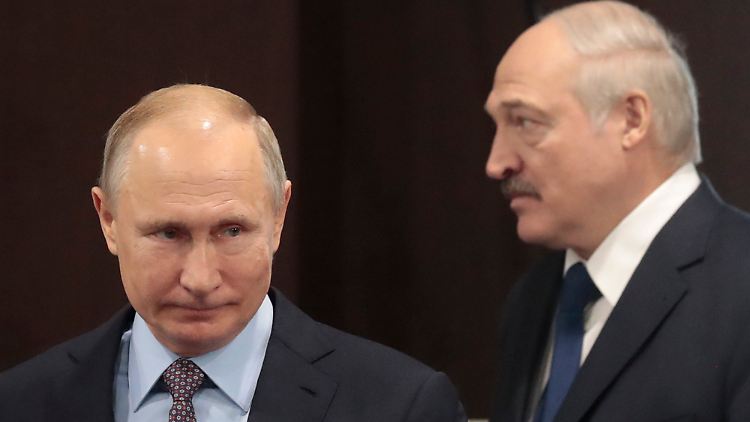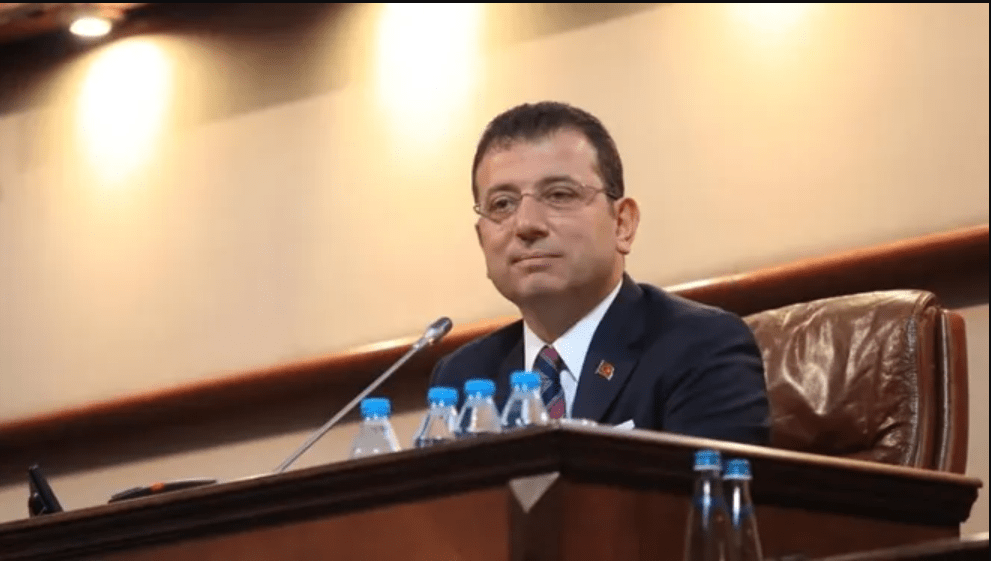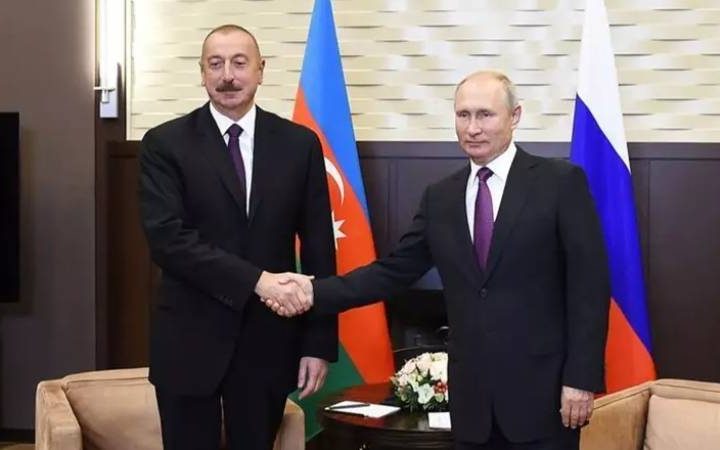The deployment of thousands of troops to Belarus raises the question of whether Russia wants to march on Kiev from the north once again. According to various sources, a covert mobilization is already underway in the neighboring country.
The extent to which Putin had miscalculated in his invasion of Ukraine became clear at the latest when Russian troops broke off their attack on Kiev barely six weeks after the start of the war and retreated to where they had started from: Belarus. Although the war has continued to rage in eastern and southern Ukraine since then, there are now increasing signs that Moscow could also reopen the “northern front” – with the involvement of the Belarusian army.
Since the start of the war, Minsk strongman Alexander Lukashenko has made every effort to loudly rhetorically cheer Russia’s offensive and condemn the “collective West” as a threatening common enemy. At the same time, he downplays his country’s role, although his regime is providing significant support for the attack. For while Belarus before 2020 still used its “security neutrality” as an important trump card in the seesaw policy between East and West, Lukashenko has been entirely dependent on Putin’s support since the peaceful protests were suppressed in order to maintain his own power.
- EU Summit in Brussels: A gas price cap against Germany
- Chronic Anxiety: Symptoms, Causes and Treatments
- 500 drones are sent to Ukraine by a Star Wars actor
And so, by 2021, Moscow had already gained an ever stronger military foothold in Belarus – through constant maneuvers, deployment of missiles, patrol flights of nuclear-capable bombers and the establishment of “army training centers.” Shortly after the war began, Minsk cleared the way for the deployment of Russian nuclear weapons through a dubious referendum. For their attack on Ukraine, Putin’s troops made intensive use of Belarusian infrastructure-rails, roads, airfields, barracks, hospitals-and the threat remained latent that Belarusian troops might also join the invasion. However, despite rumors, this did not happen and there was often speculation as to whether Lukashenko was actively opposing Putin or whether Putin had simply not yet put enough emphasis on such a “request.
Covert mobilization is apparently already underway in Belarus
After the “regrouping” of the Russian attack towards the southeast, Belarus again fell out of sight for many. Significantly fewer missile attacks emanated from there, and a bit of normalcy returned in Kiev near the border. But since the partial mobilization in Russia, the Ukrainian counteroffensive and the explosion on the Crimean Bridge, the picture is changing. Putin urgently needs fighters and weapons to turn the tide in his favor, or at least to shore up the land grab so far. A “reopening” of the front in the north with Belarusian participation appears to be an obvious option, and various factors suggest that this is being actively prepared.
First, Lukashenko again sharpened the rhetoric after the recent meetings with Putin. He said that his country has long been part of the “special operation” and supports Russia in “every possible way.” Belarus is not planning an attack, but it will defend the homeland in the event of a “provocation by Ukraine.” The fact that such a provocation is imminent is spread by propaganda on all channels – even the Ukrainian ambassador was summoned by the media. Similarly, the head of the Belarusian KGB, Ivan Tertel, has recently been inculcating war rhetoric in the workforces of state-owned enterprises. And it does not stop at words.
According to various sources, covert mobilization is already underway in Belarus. Military units are being put on “high combat readiness,” personnel and equipment are being increased to war level, and constant drills and exercises are being held. Following the announcement of “inspections,” extensive mustering of recruits is taking place, especially in the regions, and military personnel have been banned from leaving the country. In addition, on October 10, the regime announced nationwide “anti-terrorist measures” that exacerbated the already high level of repression and fueled the climate of fear. At the start of the war, there had again been spontaneous protests in Belarus, followed by sabotage actions against the railroad network. Most recently, the democratic forces in exile announced that they had worked out a plan to overthrow the regime on “Day X” with the help of up to 200,000 already registered Lukashenko opponents, including members of the security forces.
Probably a diversionary tactic
Both Lukashenko and Putin know that while polls show about half of Belarusians follow the Russian propaganda narrative, nearly 90 percent oppose active participation by the Belarusian army in the war. A too-obvious entry into the war with many casualties could ignite a new protest dynamic despite all these repressions, which both want to prevent. There are also doubts about the fighting morale of the Belarusian soldiers, who in any case number barely more than 15,000 regular combat-ready soldiers, not to mention freshly drafted recruits. It is therefore still unclear what scenario the increased activities in Belarus will lead to.
At a recent summit in Kazakhstan, Putin railed that the Ukrainian “authorities” had lost the “will to negotiate” after the withdrawal of his troops from the Kiev area. So he could be aiming to force President Volodymyr Zelenskyy to make territorial concessions after all by a new push on the capital and end the war in a “face-saving” way. However, this does not seem very promising. Nevertheless, at the beginning of October Minsk and Moscow announced the formation of a joint regional combat group, which is to comprise the impressive number of 70,000 soldiers and be under a joint command. Under Russian control, Belarusian soldiers could thus remain in Belarus in the event of a new offensive and provide, for example, supplies, maintenance and logistics – the areas in which the Russians were so sorely lacking in March. But even though thousands of Russian soldiers, including modern combat equipment, have recently been redeployed to Belarus, this target is still a long way off. At best, it could be reached next spring, and such a deployment would not remain hidden. Observers such as the British intelligence service therefore speak at the moment rather of a large diversionary maneuver.
It remains to be seen whether Minsk and Moscow actually expect that Kiev, under the impression of a possibly imminent new attack on Kiev, would not wait, but would shell barracks and ammunition depots in Belarus – thus giving the propaganda there an excuse to “defend” itself. Yet Kiev has never officially taken responsibility for counterattacks on Russian territory. Since Russia and Belarus are linked in the “Union State” and the CSTO military alliance as a defense community, such a move on Ukraine’s part would be unlikely. However, should Russian-Belarusian propaganda require a “provocation,” it could be self-produced as a “false flag” operation if necessary.
Then a “reopening” of the northern front could also take the form of widely scattered “pinpricks” instead of a major advance. The Ukrainian-Belarusian border, after all, measures a good 1,000 km, and limited advances by ground troops or pure artillery strikes would have the potential to tie up substantial Ukrainian troops in the north, which would be lacking for the counteroffensive in the east and south. The effect apart from that, however, would be a long attrition battle with high destruction and limited military utility. But Russia has already had practice at this as well.
In any case, the latest events demonstrate once again how important Belarus’s slide into totalitarianism and its subjugation were and remain for Putin’s war plans, and that peace in the region can only be secured in the long term if Belarus also returns to the circle of peaceable countries as an independent, free state.
the main source of the news: https://www.n-tv.de/politik/





